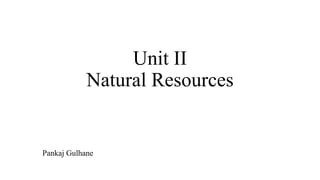
Unit II.pptx
- 1. Unit II Natural Resources Pankaj Gulhane
- 2. Introduction • Ecosystems act as resource producers and processors. • Solar energy is the main driving force of ecological systems, providing energy for the growth of plants in forests, grasslands and aquatic ecosystems. • A natural resource may be defined as any material given to us by nature which can be transformed in a way that it becomes more valuable and useful.
- 4. Natural Resources Problems • The unequal consumption of natural resources • Planning Landuse • The need for sustainable lifestyles
- 5. Natural Resources • The quality of the ecosystems have indicators that are more difficult to assess. A stabilized population. The long term conservation of biodiversity. The careful long-term use of natural resources. The prevention of degradation and pollution of the environment.
- 6. Natural Resources Non-renewable resources: • Non-renewable resources are natural resources that cannot be replaced after they are used. This means that they exist in a fixed amount on Earth. Rock, minerals, metals, uranium, and fossil fuels such as petroleum, coal, and natural gas are all non-renewable resources. • Ex The end products of fossil fuels are in the form of heat and mechanical energy and chemical compounds, which cannot be reconstituted as a resource.
- 7. Natural Resources Non-renewable resources: • Uranium is a radioactive element that occurs with many other minerals in Earth’s crust. Uranium ore is removed from the Earth by mining. The mined ore is crushed and the uranium is chemically extracted. Uranium ore is an important source of nuclear fuel. One pound of uranium produces as much energy as 3 million pounds (1.4 million kilograms) of coal.
- 8. Natural Resources Non-renewable resources: • Inorganic non-renewable resources such as uranium, minerals, metals, and petroleum-derived products such as plastics are not biodegradable. • Some non-renewable resources that formed from organic matter are biodegradable. For example, liquid petroleum can be degraded by oil-eating bacteria that break down the hydrocarbons in oil.
- 9. Natural Resources Renewable resources: • A renewable resource is a natural resource that cannot be used up or it is one that can be replaced within a human life span. Air, water, soil, plants, and animals are examples of renewable resources. • All living things need air, making this one of the most essential natural resources. Air surrounds Earth as the atmosphere. • Water is one of the most important natural resources. All living things need fresh water to survive.
- 10. Natural Resources Renewable resources: • Soil provides water and nutrients for plants and soil-dwelling organisms such as bacteria, worms, and fungi. • Soil supplies a medium for filtering and breaking down wastes and plays a critical role in cycling carbon and other elements through Earth’s systems. Only a thin layer of soil, called topsoil, can support plant life, including crops grown for food.
- 11. Natural Resources Renewable resources: • Plants and animals are renewable resources of great importance to humans. • Trees and plants provide food and raw materials for products ranging from clothing and furniture to medicines and fuels. • Animals provide food and other products useful to humans. • Plant matter and animal wastes are sources of alternative energy. Such energy sources are often termed biofuels because they come from living organisms.
- 12. Natural Resources Renewable resources: • Plants and animals are renewable resources of great importance to humans. • Trees and plants provide food and raw materials for products ranging from clothing and furniture to medicines and fuels. • Animals provide food and other products useful to humans. • Plant matter and animal wastes are sources of alternative energy. Such energy sources are often termed biofuels because they come from living organisms.
- 13. Natural Resources Renewable resources: • Most organic renewable resources—plants, animals, and related products and wastes—are biodegradable. • Biodegradation occurs when microorganisms degrade, or break down, organic matter into inorganic substances that can be used by other organisms or recycled through Earth’s systems. • The rate at which materials are degraded depends upon the type of material and conditions such as moisture, sunlight, and heat.